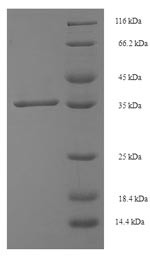Amino acids 1-177 constitute the expression domain of recombinant Human SMUG1. This SMUG1 protein is expected to have a theoretical molecular weight of 35.6 kDa. Expression of this SMUG1 protein is conducted in e.coli. Fusion of the N-terminal 6xHis-SUMO tag into the SMUG1 encoding gene fragment was conducted, allowing for easier detection and purification of the SMUG1 protein in subsequent stages.
Human single-strand selective monofunctional uracil DNA glycosylase (SMUG1) is a DNA repair enzyme crucial for base excision repair. SMUG1 specifically recognizes and removes uracil from single-stranded DNA, preventing mutagenesis. In genomics, SMUG1 is essential for maintaining genome integrity and stability. Research on SMUG1 extends to immunology, where it influences somatic hypermutation during antibody maturation. Additionally, SMUG1 is implicated in neurobiology, playing a role in oxidative DNA damage repair in neurons. Investigating SMUG1 provides insights into DNA repair mechanisms, genomic stability, and disease susceptibility, offering potential applications in understanding and preventing mutagenic events, as well as implications for immunology and neurological disorders.






